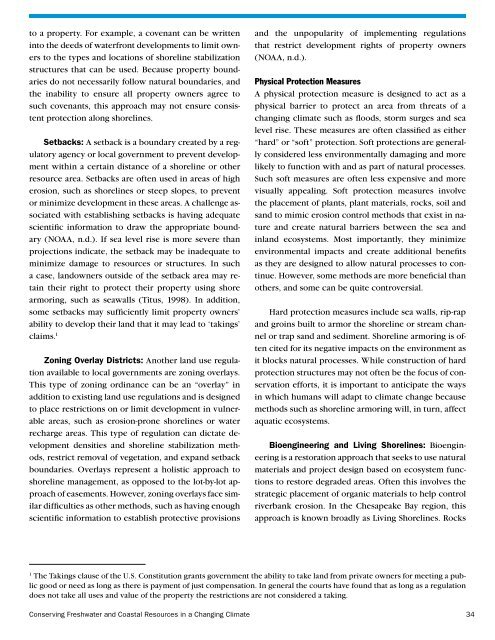Conserving Freshwater and Coastal Resources in a Changing Climate
Conserving Freshwater and Coastal Resources in a Changing Climate
Conserving Freshwater and Coastal Resources in a Changing Climate
You also want an ePaper? Increase the reach of your titles
YUMPU automatically turns print PDFs into web optimized ePapers that Google loves.
to a property. For example, a covenant can be written<br />
<strong>in</strong>to the deeds of waterfront developments to limit owners<br />
to the types <strong>and</strong> locations of shorel<strong>in</strong>e stabilization<br />
structures that can be used. Because property boundaries<br />
do not necessarily follow natural boundaries, <strong>and</strong><br />
the <strong>in</strong>ability to ensure all property owners agree to<br />
such covenants, this approach may not ensure consistent<br />
protection along shorel<strong>in</strong>es.<br />
Setbacks: A setback is a boundary created by a regulatory<br />
agency or local government to prevent development<br />
with<strong>in</strong> a certa<strong>in</strong> distance of a shorel<strong>in</strong>e or other<br />
resource area. Setbacks are often used <strong>in</strong> areas of high<br />
erosion, such as shorel<strong>in</strong>es or steep slopes, to prevent<br />
or m<strong>in</strong>imize development <strong>in</strong> these areas. A challenge associated<br />
with establish<strong>in</strong>g setbacks is hav<strong>in</strong>g adequate<br />
scientific <strong>in</strong>formation to draw the appropriate boundary<br />
(NOAA, n.d.). If sea level rise is more severe than<br />
projections <strong>in</strong>dicate, the setback may be <strong>in</strong>adequate to<br />
m<strong>in</strong>imize damage to resources or structures. In such<br />
a case, l<strong>and</strong>owners outside of the setback area may reta<strong>in</strong><br />
their right to protect their property us<strong>in</strong>g shore<br />
armor<strong>in</strong>g, such as seawalls (Titus, 1998). In addition,<br />
some setbacks may sufficiently limit property owners’<br />
ability to develop their l<strong>and</strong> that it may lead to ‘tak<strong>in</strong>gs’<br />
claims. 1<br />
Zon<strong>in</strong>g Overlay Districts: Another l<strong>and</strong> use regulation<br />
available to local governments are zon<strong>in</strong>g overlays.<br />
This type of zon<strong>in</strong>g ord<strong>in</strong>ance can be an “overlay” <strong>in</strong><br />
addition to exist<strong>in</strong>g l<strong>and</strong> use regulations <strong>and</strong> is designed<br />
to place restrictions on or limit development <strong>in</strong> vulnerable<br />
areas, such as erosion-prone shorel<strong>in</strong>es or water<br />
recharge areas. This type of regulation can dictate development<br />
densities <strong>and</strong> shorel<strong>in</strong>e stabilization methods,<br />
restrict removal of vegetation, <strong>and</strong> exp<strong>and</strong> setback<br />
boundaries. Overlays represent a holistic approach to<br />
shorel<strong>in</strong>e management, as opposed to the lot-by-lot approach<br />
of easements. However, zon<strong>in</strong>g overlays face similar<br />
difficulties as other methods, such as hav<strong>in</strong>g enough<br />
scientific <strong>in</strong>formation to establish protective provisions<br />
<strong>and</strong> the unpopularity of implement<strong>in</strong>g regulations<br />
that restrict development rights of property owners<br />
(NOAA, n.d.).<br />
Physical Protection Measures<br />
A physical protection measure is designed to act as a<br />
physical barrier to protect an area from threats of a<br />
chang<strong>in</strong>g climate such as floods, storm surges <strong>and</strong> sea<br />
level rise. These measures are often classified as either<br />
“hard” or “soft” protection. Soft protections are generally<br />
considered less environmentally damag<strong>in</strong>g <strong>and</strong> more<br />
likely to function with <strong>and</strong> as part of natural processes.<br />
Such soft measures are often less expensive <strong>and</strong> more<br />
visually appeal<strong>in</strong>g. Soft protection measures <strong>in</strong>volve<br />
the placement of plants, plant materials, rocks, soil <strong>and</strong><br />
s<strong>and</strong> to mimic erosion control methods that exist <strong>in</strong> nature<br />
<strong>and</strong> create natural barriers between the sea <strong>and</strong><br />
<strong>in</strong>l<strong>and</strong> ecosystems. Most importantly, they m<strong>in</strong>imize<br />
environmental impacts <strong>and</strong> create additional benefits<br />
as they are designed to allow natural processes to cont<strong>in</strong>ue.<br />
However, some methods are more beneficial than<br />
others, <strong>and</strong> some can be quite controversial.<br />
Hard protection measures <strong>in</strong>clude sea walls, rip-rap<br />
<strong>and</strong> gro<strong>in</strong>s built to armor the shorel<strong>in</strong>e or stream channel<br />
or trap s<strong>and</strong> <strong>and</strong> sediment. Shorel<strong>in</strong>e armor<strong>in</strong>g is often<br />
cited for its negative impacts on the environment as<br />
it blocks natural processes. While construction of hard<br />
protection structures may not often be the focus of conservation<br />
efforts, it is important to anticipate the ways<br />
<strong>in</strong> which humans will adapt to climate change because<br />
methods such as shorel<strong>in</strong>e armor<strong>in</strong>g will, <strong>in</strong> turn, affect<br />
aquatic ecosystems.<br />
Bioeng<strong>in</strong>eer<strong>in</strong>g <strong>and</strong> Liv<strong>in</strong>g Shorel<strong>in</strong>es: Bioeng<strong>in</strong>eer<strong>in</strong>g<br />
is a restoration approach that seeks to use natural<br />
materials <strong>and</strong> project design based on ecosystem functions<br />
to restore degraded areas. Often this <strong>in</strong>volves the<br />
strategic placement of organic materials to help control<br />
riverbank erosion. In the Chesapeake Bay region, this<br />
approach is known broadly as Liv<strong>in</strong>g Shorel<strong>in</strong>es. Rocks<br />
1<br />
The Tak<strong>in</strong>gs clause of the U.S. Constitution grants government the ability to take l<strong>and</strong> from private owners for meet<strong>in</strong>g a public<br />
good or need as long as there is payment of just compensation. In general the courts have found that as long as a regulation<br />
does not take all uses <strong>and</strong> value of the property the restrictions are not considered a tak<strong>in</strong>g.<br />
<strong>Conserv<strong>in</strong>g</strong> <strong>Freshwater</strong> <strong>and</strong> <strong>Coastal</strong> <strong>Resources</strong> <strong>in</strong> a Chang<strong>in</strong>g <strong>Climate</strong><br />
34

















